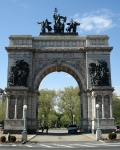Grand Army Plaza
Archaeology »
Archaeological Monuments » Grand Army Plaza
Grand Army Plaza - United States
Grand Army Plaza is located in Brooklyn,New York.
Grand Army Plaza monument was established on 1870.
Primary threats to Grand Army Plaza :
It consists of concentric rings arranged as streets, with the outer ring being named Plaza Street. The inner ring was originally intended to be a circle, but it actually was arranged as a main street.
Historical facts of Grand Army Plaza :
- Grand Army Plaza is a historically significant landmark located in Brooklyn, New York City. It is a public square that serves as a tribute to the Union Army and its soldiers who fought in the American Civil War. The plaza is adorned with various monuments and architectural features, making it an important historical and cultural site.
- The idea for Grand Army Plaza was conceived in the late 19th century as a way to honor the Union Army and commemorate the victory of the Civil War. The plaza's design was heavily influenced by the classical architecture of Europe, with inspiration drawn from prominent public spaces such as the Place de l'Étoile in Paris.
- One of the most prominent features of Grand Army Plaza is the Soldiers' and Sailors' Arch, designed by architect John H. Duncan. The arch serves as the main entrance to Prospect Park and stands as a majestic tribute to the soldiers and sailors who fought for the Union during the Civil War. It is adorned with intricate sculptures and reliefs that depict military scenes and symbolize victory and freedom.
- Another significant monument in Grand Army Plaza is the Bailey Fountain, located at the center of the plaza. The fountain was designed by architect Eugene P. Connet and features a bronze sculpture of a female figure holding a large basin from which water flows. The fountain serves as a symbol of the life-giving force of water and represents the rejuvenation and rebirth of the nation after the Civil War.
- Grand Army Plaza also features a large bronze equestrian statue of General William Tecumseh Sherman, created by sculptor Augustus Saint-Gaudens. General Sherman was a prominent Union Army general known for his military strategies and his role in bringing the Civil War to a close. The statue pays tribute to his contributions and serves as a reminder of the sacrifices made by Union soldiers.
- The plaza's design incorporates landscaped gardens, pedestrian walkways, and elegant lampposts, creating a visually stunning environment. It has become a popular gathering place for community events, rallies, and celebrations.
- Throughout its history, Grand Army Plaza has undergone several renovations and improvements to maintain its historical integrity. Efforts have been made to preserve and restore the architectural features and monuments, ensuring that future generations can continue to appreciate and learn from the site's historical significance.
- Today, Grand Army Plaza stands as a vibrant public space that combines history, art, and culture. It serves as a focal point for community engagement and provides a setting for reflection on the sacrifices made during the Civil War. The plaza continues to be a significant landmark in Brooklyn, attracting locals and tourists alike with its grandeur and historical importance.
- Visiting Grand Army Plaza offers individuals an opportunity to connect with the past and gain a deeper understanding of the impact of the Civil War on American society. It serves as a reminder of the courage and resilience of the Union soldiers and their role in shaping the nation's history. Grand Army Plaza stands as a tribute to their legacy and serves as a symbol of unity, freedom, and remembrance.

